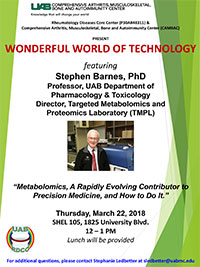GBSC 724 Advanced Graduate Course on Metabolomics
January 8 – April 12, 2024
SHELBY 1115
9:00-10:30 am M/W/F
What is the metabolome? The metabolome is the group of small molecules that are found in a given organism’s tissues and biological fluids. It represents far more than what you see in classical metabolic pathway charts. Since mammals, including humans, are metabolically gene-deficient (for instance, only 10 of the 20 amino acids in human proteins are made by human genes), they are required to eat foods derived from other organisms. In doing so, they (we) eat all the products of these other genomes, whether it’s a diet based on meat (chicken, cow, fish, pig, sheep, insects, etc.) or fruits, grains and vegetables. Foods also include staple foods modified by fermentation by bacteria, yeasts and other microorganisms. Besides foods, mammals carry around their own population of microorganisms, in particular the gut microbiome, which create metabolites from their metabolic pathways. Therefore, a mammal is highly polygenomic with regard to its metabolome.
What about the metabolome in patients? In the world of clinical medicine, the metabolome is made more complex because the (occasional or chronic) use of therapeutic drugs as well as recreational and over-the-counter drugs, in addition to food additives and other chemicals that are part of modern life (insecticides, fire retardants, sunscreens and other cosmetics, etc.). Thus, metabolomics has become an important part of precision medicine to determine if a patient is adhering to a prescribed medication, or is adding to, or is exposed to other pharmacologically active compounds
How do we collect data on the metabolome? There are two major methods – nuclear magnetic resonance (NMR) and various combinations of chromatography (for separation) and mass spectrometry (for mass determination). These include gas chromatography (GC-MS), liquid chromatography (LC-MS) and capillary electrophoresis (CE-MS). As for analysis of other -omics, prodigious amounts of data are created.
How do we analyze metabolomics data? While instrumentation companies provide comprehensive software for data processing, statistical and pathway analysis, the scientific community is making rapid progress in developing freely available software tools. These will be discussed in class and participants will carry out hands-on analyses with them. Accelerating data analysis is critical.
What does this course provide? It will outline (1) the obvious and hidden metabolome, (2) the design needs of a metabolomics experiment, (3) how to capture metabolomics data, (4) how to carry out pre-processing, alignment, quantitative and statistical analysis of data features, (5) how to identify NMR resonances and MS ion features, (6) how to carry out pathway analysis, (7) isotopic tracing of metabolic pathways and finally (8) how to integrate metabolomics data with data from transcriptomics and proteomics experiments. This will allow the creation of specially designed, future experiments.
Coursemaster: Stephen Barnes, PhD; BBRB 711: (205) 934-7117/(205) 410-3266, sbarnes@uab.edu



